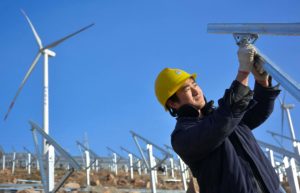Despite the economic challenges posed by Covid-19, the past year was marked by a growing number of pledges from countries to reach carbon neutrality or net-zero emissions, and policy developments to achieve those goals.
China and the EU after the pandemic
Read more from this series, in which we compare the post-Covid policies of China and the European Union, and how their relationship is evolving
For many Asian countries, the direction points toward emissions trading systems (ETSs) as a pillar of climate policy. Many have taken critical steps to launch, enhance and develop carbon markets in the past year, the Emissions Trading Worldwide Status Report 2021 shows. The report produced annually by the International Carbon Action Partnership, shows that China’s launch of what is now the world’s largest ETS has nearly doubled the share of global emissions covered by an ETS to 16%.
We anticipate this interest in carbon pricing, and particularly carbon markets, to grow as countries look for tools to help them transition to more sustainable economies and reach their climate goals, especially those adopting net-zero targets.
Effective carbon markets can help countries reach their climate neutrality goals in a cost-efficient manner. The pre-determined limit on emissions under an ETS provides covered sectors with certainty on how far they need to abate emissions, so countries, cities and other jurisdictions can work backwards from their climate targets when setting the cap. This provides clarity to ETS-covered sectors on how far they need to cut back their emissions. Carbon markets, often with stability provisions woven into their design, can provide the long-term, credible price signal necessary to give market players confidence to invest in abatement and low-carbon innovation. Revenues from auctioned allowances can also be used to fund further climate action or companion policies in the transition to net-zero, such as support for renewable energy, research and development, or the deployment of low-carbon technologies.
Developments across Asia
Countries in Asia are at different stages in terms of carbon-pricing readiness and development. Heavy-weights China, Japan and South Korea have recently underlined their ambition with mid-century net-zero pledges. South Korea’s ETS is more mature. Launched in 2015, it is now entering a new stage of development with, for example, an increased share of auctioning under its third trading phase to begin in July of this year.
Indonesia and Vietnam are also actively developing their own carbon markets. While building infrastructure around data collection and monitoring, Indonesia has conducted several studies on market-based instruments and is currently finalising regulation for a carbon pricing framework. Meanwhile, Vietnam has established the legal mandate to design a domestic ETS and crediting mechanism, with a pilot scheduled for 2025 and a fully operational system by 2027.
Japan’s net-zero pledge has given the country’s carbon-pricing debate new momentum, with Prime Minister Yoshihide Suga instructing relevant ministries to develop a carbon-pricing proposal. Thailand has built on previous pilot testing with industrial sectors to develop the infrastructure for a possible future system. Finally, the Philippines is considering a legislative mandate for emissions trading. As the region looks ahead, it is clear that carbon pricing, and carbon markets in particular, are pillars in many countries’ green growth strategies.
The launch of China’s national ETS
Drawing the most attention, however, is China. A few months after President Xi Jinping announced China’s vision to achieve peak carbon emissions before 2030 and carbon neutrality before 2060, China announced the first compliance period of its national ETS beginning this year – marking a major milestone on the country’s decade-long endeavour to explore a market-based instrument to achieve its mitigation targets.
China’s national ETS takes a “soft” approach to begin with, and covers only the electricity sector, though it’s expected to expand to other industries. It starts with an intensity-based cap, meaning there is no hard limit on emissions. Emission allowances are distributed for free using benchmarks. Natural gas-fired plants face no additional costs and coal-fired plants are required to buy additional allowances only to cover up to 20% of emissions that exceed the benchmark. So for example, if a plant were allowed to emit 100,000 tonnes of CO2 based on the amount of electricity it produces but actually emitted 200,000 tonnes, it would only need to pay for 20,000 tonnes’ worth of extra allowances. The cap is set bottom-up, that is, as a sum of the total allowance allocation for all covered entities. It is an intensity-based cap, which changes according to actual production levels. The cap is formed by adding up all the freely distributed allowances based on benchmarks and benchmark year’s production levels plus ex-post adjustments made based on the respective compliance year’s production levels. The allocation system also treats some facilities operating at below-normal capacity more generously and includes low fines for non-compliance at the beginning. In the future, the system would need to become stronger to be fit for the carbon peaking and net-zero targets.
Lessons from other carbon markets to strengthen China’s national ETS
Fortunately, there are many lessons China can draw from the experiences of other ETSs around the world, all of which have undergone reforms during their market development and continue to pursue policy improvements.
Firstly, the limited obligations to emitters under the initial free allocation system – a feature unique to China – should be quickly modified to full obligations for all facilities, meaning all emissions above the benchmark should face a cost, regardless of the type of power generation. This will allow the ETS to be more in line with the “polluter pays” principle.
Related to this, the stringency of the benchmarks used for allocation, especially in the current setting of the national ETS, is critical for the carbon market’s overall effectiveness and should be increased over time. Other systems like the EU ETS and California Cap and Trade also review and update benchmarks over time. For example, in the current phase, the EU is applying an annual reduction rate on benchmarks of between 0.2% and 1.6%, depending on an assessment of potential technological improvements in each sector. It will make further adjustments year-on-year.
Next, the current intensity-based cap needs to shift to an absolute cap to provide better market predictability for the participants and more certainty on the overall emissions of the facilities covered by the system, which is critical to aligning with long-term climate targets. Several domestic thought leaders, such as Zhou Xiaochuan, former governor of the People’s Bank of China, have called for the country to set annual carbon emissions caps.
Almost all carbon markets – including China’s regional ETS pilots – have relied on predominantly free allocation at the outset, but the share of allowances distributed for free needs to go down over time (see the share of auctioned allowances in existing systems in the infographic above). Systems generally increase the role of auctioning as they develop, which helps provide a clear price signal, improves market liquidity and minimises distortions to abatement incentives. In addition, governments can use the revenues generated to support further climate action or to address adverse distributive outcomes (see how existing systems use their revenues in the infographic below).
Long-running ETSs have also seen the importance of ensuring a degree of predictability and stability in their allowance prices to encourage low-carbon investment, as well as a need to respond to unexpected shocks such as the global financial crisis of 2007-2008 or the economic impacts of Covid-19. To do this they’ve established mechanisms that adjust the price or quantity of allowances based on market conditions. In considering its approach, China should draw from these experiences, such as the EU Market Stability Reserve or the price floors and cost-containment reserves that exist in North American ETSs.
Lastly, China should consider measures to stimulate an active and liquid carbon market. Diversifying the market participants and trading products are important steps to enhance the liquidity over time. In the EU and California, market participants that have no obligations to surrender allowances under an ETS, such as financial institutions, are playing an important role. South Korea is also taking steps to introduce more sellers in its ETS and to allow financial intermediaries to participate in its secondary market.
China now has a strong foundation in market-based carbon pricing and a wealth of experience from which to draw to enhance the national ETS in the years ahead. But its effective governance cannot be neglected. China has established a three-tiered structure with the Ministry of Environment and Ecology (MEE) at the head and its subsidiaries at the provincial and municipal levels below. This follows a reshuffling of ETS responsibilities from the National Development and Reform Commission just a year ago. One challenge ahead is enhancing institutional capacities along all three levels of this new governance structure and establishing cross-ministerial coordination at the national level, all of which will be critical to expanding the ETS to additional sectors.
China can now position its national ETS within its wider array of climate and energy policies. For the ETS to become a key pillar in emissions abatement, there will need to be a longer-term cap trajectory aligned firmly with the country’s mitigation targets and an understanding of the impacts that other policies will achieve. China’s path towards building an effective national carbon market will be of global relevance.








